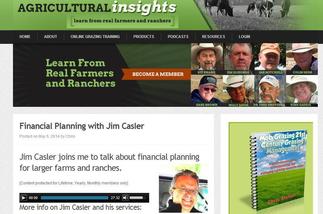|
6. Vision, Mission and Goals
Often considered “fluff” or “soft” ideas, this step is indeed one of the most crucial. Aside from individual goals (step #1), this step is critical for business and even more so when planning for your business succession. A common vision of your business holds the transition plan together. It is the guiding philosophy for business operations and reflects the combined individual core values of both generations. |
7. Strategic Planning (Long-Term Planning)
A clearly understood and agreed upon plan that incorporates the goals and strengths of individuals as well as the resources available to the business gets everyone, including off-farm extended family members, pointed in the same direction, walking down the same path, hand-in-hand – a force and energy that becomes unstoppable. Once the vision is established, the mission understood, the objectives are defined and goals are articulated – they are all combined into a long-term strategic plan for the business. It is a beautiful thing to watch a family come together as a business unit. It is a healthy cycle when the business improves family relations and strong family relations improve business performance and so on. This business plan is particularly important when communicating with lenders, vendors and business partners, and even more important when the business is growing and expanding which is often required to support additional families.
8. Financial Feasibility
This is where the rubber meets the road and detailed financial projections are developed into a financial roadmap for the business. This step involves using or developing farm records to better understand your financial position to make more informed decisions. This long-range planning, cash-flow analysis and a more formal financial plan allow you to know whether you are on track or not. As plans develop, sensitivity analysis will also be needed to anticipate the impacts of and reduce the risks from financial road bumps caused by death, divorce, disability, etc.
9. Financial Security Planning & Business Structure Analysis
No succession plan for your business can be sustainable without addressing estate planning…and not just for the senior generation but for the successor generation as well. There is a great deal of complexity and interdependence on how the business is structured (sole proprietorship, partnership, corporation, limited liability company, etc.), the decision-making structure of the business, the financial structure of the business (who owns and who owes what and how are profits calculated and shared) and the implication of income taxes, estate taxes and how assets can be passed between generations. Indeed, it can be a complicated web of concepts and strategies. Time spent in this area is the fine-tuning of intentions developed earlier specifically put in writing and made legal. It helps avoid future conflict for successors and helps provide a clear understanding of the financial future for the senior generation. While it’s not likely that you enjoy spending hours with professional advisors reviewing legal documents and tax strategies, taking the time to develop a clear plan and communicating that plan to everyone is truly a gift for you and your family.
|
10. Action Plans / Implementation Now it’s time to put all of this into action with a timeline including who is responsible for what. There must be time allowed for management transition and respect for the senior generation’s financial security needs. Plans will evolve over time and need to provide some flexibility for changes in circumstances. |
One way or another, transition will happen for your family business. It is literally unavoidable. The business can be sold, go out of business, languish until your death or transition to the next generation during your lifetime.
Effective communication and formal business planning can help increase the odds that your family farm can be properly positioned for a successful generational transfer. It’s certainly a puzzle that can be put together.
Is it worth the time and effort to follow a Do-It-Yourself approach and hope for the best, or invest a small, ridiculous fraction of your net worth to employ others to help your business through this process?



 RSS Feed
RSS Feed
